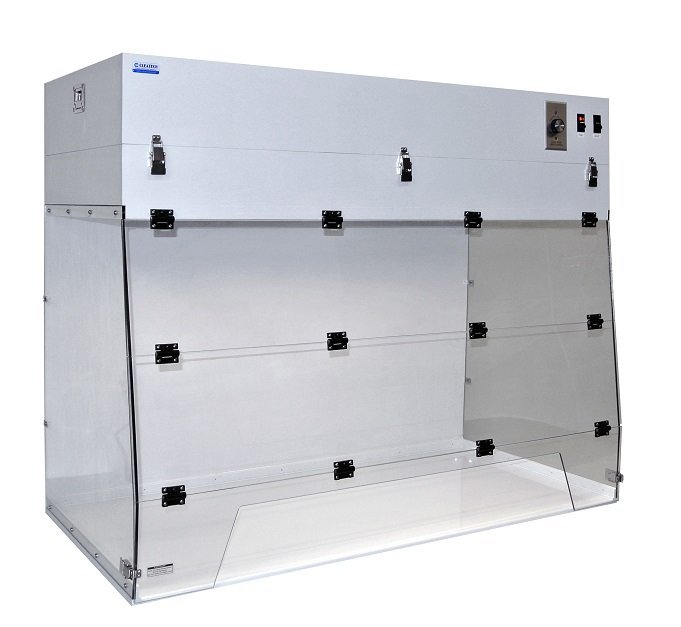Laboratory fume hoods play a critical role in ensuring the safety and well-being of laboratory personnel by effectively controlling and containing hazardous fumes, vapors, and airborne particles. These specialized pieces of equipment are designed to provide ventilation, preventing the release of harmful substances into the laboratory environment. Understanding the key components of a laboratory fume hood is essential for maintaining a safe working environment and complying with regulatory standards. In this article, we will explore the various components, design considerations, performance standards, and maintenance practices associated with laboratory fume hoods, provided by Cleatech, LLC.
Definition and purpose of laboratory fume hoods
Let’s start with the basics. If you’ve ever been in a chemistry lab (or watched a high school science movie), you’ve probably seen those big, enclosed cabinets with a glass front. Yep, those are laboratory fume hoods. They may look a bit intimidating, but they actually play a crucial role in keeping lab workers safe.
Fume hoods are designed to protect researchers from exposure to harmful chemicals, vapors, and gases that are released during experiments. They work by capturing these hazardous substances and directing them out of the lab, preventing them from being inhaled by the scientists, and creating a safer work environment.
Importance of fume hoods in laboratory safety
Lab safety is no joke. I mean, who wants to end up like a mad scientist in a cheesy movie? Fume hoods are essential for maintaining a safe working environment in laboratories. They help prevent accidental inhalation of toxic substances, reduce the risk of chemical spills and fires, and protect researchers from potential health hazards. So, if you’re ever in a lab and you see a fume hood, remember to appreciate the role it plays in keeping everyone safe and sound.
Importance of proper ventilation and containment
Role of ventilation in fume hood performance
Ventilation is like a breath of fresh air (quite literally) in the world of fume hoods. Proper ventilation plays a critical role in their performance. Fume hoods rely on a constant flow of air to effectively capture and remove hazardous substances. This airflow is typically controlled by fans or blowers that create negative pressure inside the hood, ensuring that any potentially harmful fumes are sucked away and exhausted out of the lab.
Contaminant containment and worker protection
Containing hazardous substances is no easy task, but fume hoods excel at it. They are designed to contain and control harmful contaminants, preventing them from spreading outside the hood and into the lab. This not only protects the researchers working directly with the chemicals but also keeps the entire lab environment safer. So, next time you’re handling some volatile chemicals, remember that your trusty fume hood has got your back.
Design and construction of laboratory fume hoods
Overview of fume hood design principles
Design is everything, darlings, and fume hoods are no exception. A well-designed fume hood ensures optimal performance and maximum safety. These hoods are typically made up of a front opening, a sash (that moveable glass part), and an exhaust system. The front opening allows scientists to access the interior of the hood while keeping them protected from the hazardous substances within. The sash can be raised or lowered to control airflow and maintain the containment of vapors. And, of course, the exhaust system ensures that all the nasty stuff is expelled from the lab, making way for pure, clean air.
Materials used in fume hood construction
When it comes to fume hood construction, the materials used are kind of a big deal. They need to be able to withstand the harsh chemicals and potentially corrosive substances that fume hoods come into contact with. That’s why you’ll often find hoods made of materials like stainless steel or chemical-resistant polymers. These materials not only ensure the durability and longevity of the fume hood but also protect researchers and the lab environment from any leaks or degradation.
Key features and components of fume hood systems
Airflow control mechanisms
Airflow control is the name of the game when it comes to fume hoods. These systems usually have adjustable dampers or fans that allow scientists to control the velocity and direction of the air inside the hood. This ensures that the fumes are being captured effectively and directed away from the researchers. So, remember, airflow control is crucial for a perfectly functioning fume hood.
Fume hood sash and visibility options
The sash is like the little window into the scientific world. It allows researchers to see inside the hood and perform their experiments while still keeping a protective barrier between them and the hazardous substances. Some fume hoods even come with fancy ventilation options, like vertical-rising sashes or sashes with additional safety features. And, let’s be honest, who doesn’t want a fume hood with a little extra pizzazz?
Monitoring instruments and alarms
To err is human, my friends, and sometimes we need a little help to stay on track. That’s where monitoring instruments and alarms come into play. Fume hoods can be equipped with various sensors and alarms to constantly monitor and ensure safe working conditions. These can include airflow sensors, gas detectors, and even alarms that warn researchers if the airflow drops below the required safety levels. It’s like having a personal safety assistant right there in your fume hood. How fancy!
So, there you have it, folks! A whirlwind tour of the key components of a laboratory fume hood. Next time you find yourself in a lab, take a moment to appreciate the trusty fume hood by your side, keeping you safe from all the chemistry craziness. Stay safe and keep experimenting!
Performance standards and safety regulations
Okay, let’s talk about everyone’s favourite subject: regulations! We all know that when it comes to a laboratory fume hood, safety is the top priority. So, what are the performance standards and safety regulations you need to keep in mind?
First off, there are international safety standards for fume hoods. These standards ensure that fume hoods are designed and manufactured in a way that protects scientists and lab personnel from harmful fumes and chemicals. It’s like having a protective bubble around you, but without the hassle of blowing bubbles yourself.
In addition to the international standards, there are compliance requirements and certifications that fume hoods need to meet. These certifications serve as the gold stamp of approval, assuring you that the fume hood has undergone rigorous testing and meets all the necessary safety standards. So, when it comes to fume hoods, it’s like shopping for the safest car on the market – you want that five-star safety rating.
Maintenance and best practices for fume hood operation
Now that you’ve got your shiny new fume hood, it’s important to know how to take care of it. Just like any high-maintenance partner (we’ve all been there), fume hoods require regular maintenance to keep them running smoothly.
Cleaning and regular maintenance procedures are essential to ensure the longevity and effectiveness of your fume hood. Think of it as giving your fume hood a spa day – a little cleaning, a little TLC, and it’ll be refreshed and ready to go. Plus, regular maintenance helps prevent any nasty surprises, like a fume hood that suddenly decides to take a vacation when you need it the most.
Of course, it’s not just about cleaning. Proper usage guidelines and safety protocols are equally important. You wouldn’t want to stick your hand in a beaker of acid without protective gloves, right? Well, the same goes for fume hood operation. Following safety protocols ensures that you and your colleagues stay safe while doing your scientific magic.
Fume hood selection considerations for different applications
let’s face it, one size does not fit all. It’s like trying to squeeze into those jeans you wore in high school – it’s just not gonna happen. Similarly, different laboratory applications require different types of fume hoods.
Consider the type of contaminants you’ll be working with and the chemical resistance of the fume hood. You don’t want your fume hood to give up on you when faced with a particularly nasty chemical. It’s like hiring a bodyguard who runs away at the first sign of trouble – not very reassuring.
Sometimes, specialized fume hoods are needed for specific applications. These specialized hoods are like superheroes with unique powers. They might have extra filtration systems or additional safety features tailored to the specific task at hand. So, if you’re dealing with particularly hazardous materials, it’s like having Batman on your side – extra protection never hurts.
Emerging trends in fume hood technology and future developments
The world of fume hoods is constantly evolving, just like technology and the latest fashion trends. Luckily, the latest developments in fume hood technology are much more exciting than skinny jeans.
Advancements in energy efficiency are a hot topic in the fume hood world. Think of it as switching from incandescent light bulbs to LED lights – it’s good for the planet and your wallet. Energy-efficient fume hoods not only reduce energy consumption, but they also help maintain a comfortable working environment. It’s like a win-win, with a side of environmental consciousness.
But wait, there’s more! New materials and enhanced safety features are also making their mark in the fume hood industry. It’s like upgrading from your old flip phone to the latest smartphone – more features, better performance, and definitely cooler. These new materials and safety features improve the overall functionality and safety of fume hoods, ensuring a better experience for scientists and lab personnel.
So, whether you’re diving into the world of fume hoods for the first time or you’re a seasoned pro, understanding the key components and considerations will set you up for success in your laboratory adventures. Stay safe, stay curious, and don’t forget to clean your fume hood!
In conclusion, laboratory fume hoods are indispensable tools for ensuring a safe and controlled working environment in laboratories. By understanding the key components and design principles, as well as adhering to safety regulations and best practices, laboratory personnel can effectively mitigate the risks associated with hazardous substances. With advancements in technology and emerging trends, such as improved energy efficiency and enhanced safety features, the future of laboratory fume hoods looks promising. By partnering with Cleatech LLC, laboratories can access high-quality fume hoods and expert guidance to ensure optimal safety and performance.














